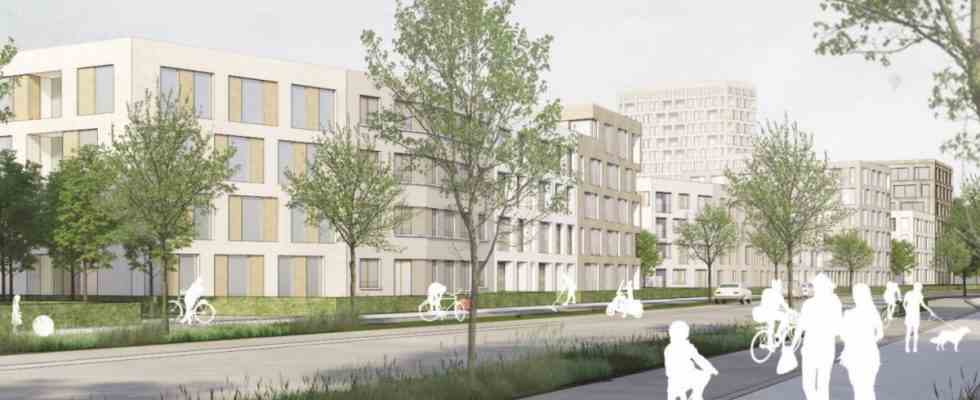The wind recently tore a few site fences from their anchorage, but that was the only one that had moved around the wasteland on Eggenfeldener Straße in the Zamdorf district for years. In addition to the empty gas station site, there is another construction project that has been on hold for some time. It’s about missed opportunities, a Bavarian real estate investor – and a new skyscraper for the east of Munich.
On a six-hectare site between the Autobahn 94 in the direction of Passau and Eggenfeldener Strasse, a commercial area is to be converted into a residential area in the coming years. About half of the site belongs to the city, the rest is privately owned. The project is being developed by Munich-based Dibag Industriebau AG, which is running the area under the name “Bogenhausen Süd”. A mixture of residential and commercial space with a floor area of 52,000 square meters is planned there.
An architectural competition for the project was announced in 2017. It was won by the “Florian Krieger Architecture and Urban Development” office from Darmstadt, whose designs also envisaged a 15-storey high-rise building in the west of the planning area. Further east, three courtyards with space for 380 apartments and a day-care center are to be built.
Delays in urban housing construction
A draft for the development plan has been available since the end of 2020. However, there are still discrepancies between the property owners, according to the “Living in Munich IV” report for the year 2021, which the Department for Urban Planning and Building Regulations presented almost exactly a year ago. The quarter on Eggenfeldener Strasse was one of the examples of why the city is not meeting the construction targets it had set itself so quickly.
So that something can still be done in the east of Munich, the city now wants to continue without the private property owners – at least as far as the residential area is concerned. “It is therefore now planned to divide the development plan area and only bring the eastern part to the statute,” says the paper from the department. Since parts of the procedure would have to be repeated as a result, the timetable has been pushed back further. The planning department assumes that the city council will not be able to finalize the details for the area until 2024.
The dispute over the site is probably also about the height development for the planned office park. In the past there was talk of a building around 60 meters high. The planning could change at this point, not least due to the newly ignited debate about Munich’s upper limit for high-rise buildings.
The planning area is directly opposite the high-rise building Süddeutsche Zeitung, which measures a good 99 meters. In addition, the Austrian investor Imfarr has bought several plots of land in the nearby commercial area between the recycling depot, S-Bahn station Berg am Laim and the Hüllgraben, on which “attractive high points” are also to be created, as the company’s website says. And the so-called commercial zone in Steinhausen, which stretches from Vogelweideplatz along the autobahn to Daglfing, is one of the places that urban planning has identified as having high-rise buildings that particularly shape the cityscape.
On Eggenfeldener Strasse, the investor expects a similar timeline as the city. “We are assuming that the development plan will be publicly displayed in 2024,” says Dibag board member Sebastian Kuhlen. The company has not provided any more information about the project. This is not surprising given that the group’s founder, Alfons Doblinger, is himself extremely reticent to the public. He gave his first interview to the SZ in 2010, when he was already 64 years old and an established figure in the real estate industry. It all started in 1990 when Doblinger bought apartments from the “Neue Heimat” portfolio. The group of companies now owns a number of particularly attractive properties in downtown Munich – including: the Kaufhof am Marienplatz.
The department for urban planning and building regulations does not want to speculate on how high it will go in Zamdorf: “To what extent the replanning will result in changes in height development cannot be conclusively assessed at this point in time,” says a department spokesman .
Six years ago, an application for the construction of a new multi-family house with an underground car park was also made on the wasteland for petrol stations opposite the Doblinger district. The construction company, which a few years ago was still advertising for homebuyers on the site, has now been liquidated. How quickly new living space will be created on the gravel site is also uncertain.

